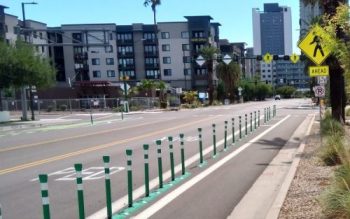The Idaho Stop is the common name for any law that allows people who are riding bicycles to treat a stop sign as a yield sign, and/or a red traffic signal as a stop sign.
It is often referred to as the Idaho Stop as Idaho was the first state to adopt the law. Examples of existing laws are shown in the appendix below.
States with Stop as Yield Laws in Place
Arkansas Effective 2019
Colorado Effective for Local Decision in 2018, State Law 2022
Delaware* Effective 2017
Idaho Effective 1982
Minnesota* Effective 2023
North Dakota* Effective 2021
Oklahoma Effective 2021
Oregon* Effective 2020
Utah* Effective 2021
Washington* Effective 2020
Washington DC* Effective 2022
*Stop sign as yield only, not stop light
States Considering Stop as Yield Laws in Recent Years
California AB73
New Jersey A 1541 Title 39
New York S 920 1231-a
Virginia HB 2262 46.2-903.1
CalBike “Bicycle Safety Stop” Efforts
There have been efforts in California over the last few legislative cycles in enact this law without success. The California Bicycle Coalition (CalBike) is one of the groups pursuing the “Bicycle Safety Stop” Law in 2023. This would allow people on bicycles to treat a stop sign as a yield sign, and would require traffic control signals be obeyed. CalBike created this video to explain the stop as yield process. https://www.calbike.org/bicycle-safety-stop-law/
Impact Study Results
Studies in Idaho and Delaware show significant decreases in crashes at stop-controlled intersections after the law was put in place.
Idaho – Bicycle injuries from traffic crashes declined 14.5%
Delaware – Traffic crashes involving bicycles at stop sign intersection declined 23%
NHTSA Fact Sheet
In their document Bicycle “Stop-As-Yield” Laws and Safety Fact Sheet, the National Highway Traffic Safety Administration included the following statements:
“Bicyclist stop-as-yield laws allow cyclists to mitigate risk to their advantage, increase their visibility to drivers and reduce exposure.”
“[T]here is no evidence showing bicyclist stop-as-yield laws have increased bike conflicts with other bikes or pedestrians.”
“When bicyclists can maintain a safe but precautionary momentum through an intersection, it allows continuous traffic flow.”
Ad Hoc National Stop as Yield Group
There is an ad hoc group of Stop as Yield advocates coordinated through CalBike. There are currently representatives from California, Illinois, New York, Virginia, Michigan, Texas, Colorado, Utah, North Dakota, League of American Bicyclists, and DC. If interested contact Walt ‘The Bike Guy’ at bikeguy@surewest.net
Current Arizona Law
- Bicyclists riding in the road have the rights and duties of the driver of any non-motorized vehicle (§28-812)
- The stop sign law (§28-855) and traffic control signal law (§28-645) require any driver of a vehicle (include non-motorized) to stop
- Law does allow one to stop and ‘proceed with caution only when it is safe’ if the traffic signal is inoperable (§28-645) with mixed results for bicycle riders as a defense in court
- Arizona does allow some local regulation of bicyclists, provided that ‘additional traffic regulations that are not in conflict’ with state law. (§28-627 §28-626)
The Coalitions of Arizona Bicyclists interpretation is that local ordinance cannot legalize Stop as Yield, and that state law change would be required. (This is not a legal opinion.)
Do you think stop as yield would be a good thing for people who ride bikes in Arizona?
Let us know by commenting below.
Appendix
Examples of Stop as Yield Laws
Idaho
49-720. Stopping — Turn and stop signals. (1) A person operating a bicycle, human-powered vehicle, or an electric-assisted bicycle approaching a stop sign shall slow down and, if required for safety, stop before entering the intersection. After slowing to a reasonable speed or stopping, the person shall yield the right-of-way to any vehicle in the intersection or approaching on another highway so closely as to constitute an immediate hazard during the time the person is moving across or within the intersection or junction of highways, except that a person, after slowing to a reasonable speed and yielding the right-of-way, if required, may cautiously make a turn or proceed through the intersection without stopping.
(2) A person operating a bicycle or human-powered vehicle approaching a steady red traffic control light shall stop before entering the intersection and shall yield to all other traffic. Once the person has yielded, he may proceed through the steady red light with caution. Provided however, that a person, after slowing to a reasonable speed and yielding the right-of-way, if required, may cautiously make a right-hand turn. A left-hand turn onto a one-way highway may be made on a red light after stopping and yielding to other traffic.
(3) A person riding a bicycle shall comply with the provisions of section 49-644, Idaho Code.
(4) A signal of intention to turn right or left shall be given during not less than the last one hundred (100) feet traveled by the bicycle before turning, provided that a signal by hand and arm need not be given if the hand is needed in the control or operation of the bicycle.
History:
[49-720, added 1988, ch. 265, sec. 209, p. 679; am. 2005, ch. 205, sec. 1, p. 615; am. 2019, ch. 84, sec. 6, p. 209.]
https://legislature.idaho.gov/statutesrules/idstat/title49/t49ch7/sect49-720/
Washington, DC
A rider approaching a stop sign may go straight through the intersection or make a turn without stopping; provided, that the rider:
(1) Is traveling at an appropriate speed to reasonably assess and avoid hazards;
(2) Determines there is no immediate hazard; and
(3) Yields the right-of-way to pedestrians and to other traffic lawfully using the intersection.”
Minnesota
Subd. 4a.Stopping requirements.
(a) For purposes of this subdivision, “in the vicinity”
means located in an intersection or approaching an intersection in a manner that constitutes a hazard of collision during the time that a bicycle operator would occupy the intersection.
(b) A bicycle operator who approaches a stop sign must slow to a speed that allows for stopping before entering the intersection or the nearest crosswalk. Notwithstanding subdivision 1 and section 169.06, subdivision 4, if there is not a vehicle in the vicinity, the operator may make a turn or proceed through the intersection without stopping.
(c) Nothing in this subdivision alters the right-of-way requirements under section 169.20.
The provisions under this subdivision do not apply when traffic is controlled by a peace officer or a person authorized to control traffic under section 169.06.



 Mike joined the Coalition board in 2022:
Mike joined the Coalition board in 2022: Billy Boyles joined the Coalition board in 2022:
Billy Boyles joined the Coalition board in 2022:

